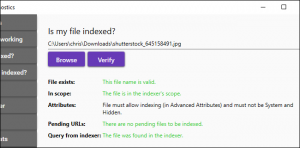Situatie
Do you have a problem with the search function in Windows 10’s Start menu or File Explorer? Whether Windows can’t find your files, indexing is using too much CPU or search isn’t working, Microsoft’s Indexer Diagnostics tool can help troubleshoot.
Solutie
This tool provides insight into the inner workings of the Windows Search indexer service, and it can help you identify problems and fixes. It’s similar to the Diagnostic Data Viewer—a power user tool that provides extra information you can’t normally see about Windows 10’s internals.
To get started, download Microsoft’s Indexer Diagnostics tool from the Microsoft Store. Launch it and give it administrator access—it needs those permissions to access and updated the Windows search indexer.
Click between the tabs in the left pane to view information about the indexing service, its status, which files it’s indexing, and what it’s searching. There are also various troubleshooting tools on this pane. The main pane is “Service Status,” which will show you how many items the indexer has in its database, and how many files it’s indexed in the last hour, day, and week.
If Windows search isn’t working at all, click “Search Is Not Working” in the left pane. Use the “Restart” button to quickly restart the search service to fix problems.
If that doesn’t help, click the “Reset” button to reset the state of the indexing service. This will take several minutes. As the interface points out, a reset “will help if the Search Indexer is stuck in a bad state.”
If search can’t find a file, click “Is my file being indexed?”, browse to the file you want Windows to find, and click “Verify.”
Windows will tell you whether the file is found in the search index and, if not, will explain why the search indexer is ignoring it so you can address any problems.
Other tools available in Indexer Diagnostics include:
- What is being indexed? – Displays the paths being indexed and any excluded paths that aren’t being indexed. You can add and remove included and excluded paths here.
- Search roots – Shows you where Windows will begin searching—for example, in the root of the C:\ directory.
- Content Viewer – View the files the indexer is indexing, and the precise time it indexed them. For example, if the search indexer was using a lot of CPU at a specific time, you can see what files it was indexing at that time and consider excluding them from “What is being indexed?”.
- Query Viewer – Monitor what search queries are being sent to the Windows search indexer. You can click “Start Listening,” perform searches, and see exactly what’s going on in the background.
- Index Item Stats – View how many items are indexed per each app on your system. You can also export details about the index to a CSV file.
- Feedback – This tab lets you collect traces and logs that will monitor the indexer’s resource usage and functions. There’s a “File Bug” button here that will let you file reports about problems with the indexer with Microsoft.
Many of these functions are only useful for developers working on the search indexer or people sending bug reports to those developers, but it’s still great to have such insight into the inner workings of Windows 10.
Microsoft has been addressing resource usage problems with the indexer—look at the fixes made in Windows 10’s May 2020 Update—and this tool suggests Microsoft’s developers are hard at work optimizing the search feature, reducing resource usage, and fixing bugs.




Leave A Comment?